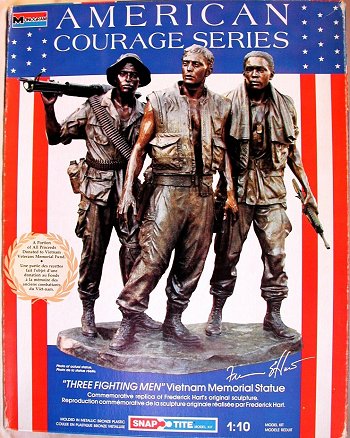
|
KIT: |
Monogram 1/10 'Three Fighting Men' |
|
KIT # |
6085 |
|
PRICE: |
$12.00 (1984) |
|
DECALS: |
N/A |
|
REVIEWER: |
|
|
NOTES: |
Currently OOP |

|
HISTORY |
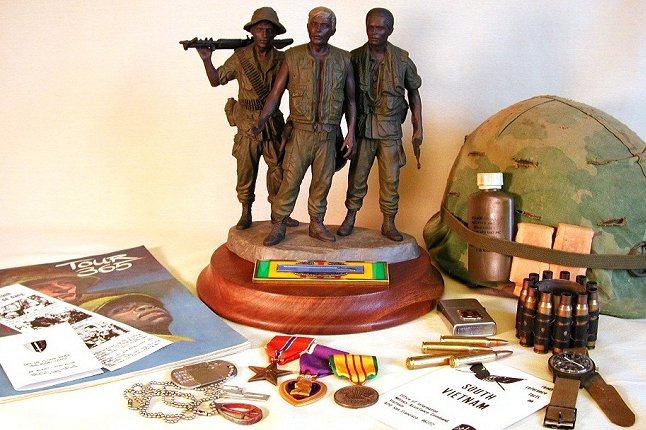
The Vietnam Veterans Memorial is the most popular attraction in Washington D.C. but the controversial design was not universally accepted by many of the nation’s veterans of that conflict or their families when the monument was first dedicated and opened for public viewing in November of 1982. Designed by architectural student Maya Lin, the polished and engraved marble slabs were derisively referred to simply as “the wall” among some quarters, lending further credence to the notion among many of the participants of the military campaign in Southeast Asia that they’d been given short shrift yet again.
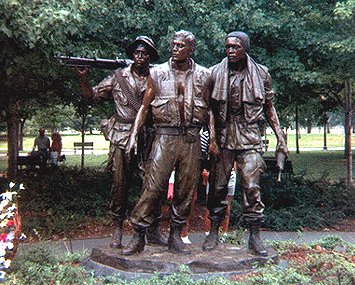 To give the memorial some
solidified focus and a more obvious sense of honor, noted sculptor Frederick E.
Hart was commissioned in 1983 to create a statue which would draw a visitor’s
attention to the real purpose of that honor; the men who served, and the
sacrifices they were called upon to make at such a young age. Though Mr. Hart
was thrilled to participate in this noble task, his workload was such that some
careful balancing was required to accommodate the request. Many of his
long-time customers willingly deferred projects so he could devote his full
attention to this endeavor.
To give the memorial some
solidified focus and a more obvious sense of honor, noted sculptor Frederick E.
Hart was commissioned in 1983 to create a statue which would draw a visitor’s
attention to the real purpose of that honor; the men who served, and the
sacrifices they were called upon to make at such a young age. Though Mr. Hart
was thrilled to participate in this noble task, his workload was such that some
careful balancing was required to accommodate the request. Many of his
long-time customers willingly deferred projects so he could devote his full
attention to this endeavor.
After sketching several different designs Frederick decided that the concept could best be served by multiple figures representing a trio of prototypical infantrymen. Models were hired, to be clad in the appropriate uniforms and equipment, and photographed from every conceivable angle to assist him in placing and posing the sculptures in a pleasing, yet dignified posture. Armed with hundreds of still photographs and several hours of videotape, Mr. Hart first created the figures individually as clay miniatures (called maquettes) and adjusted each ‘soldier’ for artistic impact while maintaining a convincing realism.
Not necessarily deliberately or
consciously, the figure in the vanguard seems to represent a young
platoon leader, bare-headed, clad in a flak vest and armed with only a holstered
service pistol. At his right wearing a boonie hat and shouldering a pig,
stands an infantry squad’s machine-gunner, a 100-rd teaser belt draped over each
shoulder. Left of the el-tee an “11-Bravo” (O310/0311 in the Marine
Corps), M-16A1 in hand and wearing his ‘lucky towel’, guards that flank.
Grunts all, the faces reflect the “thousand-meter stare” so prevalent among
troops who’ve seen too much of the bush for far too long.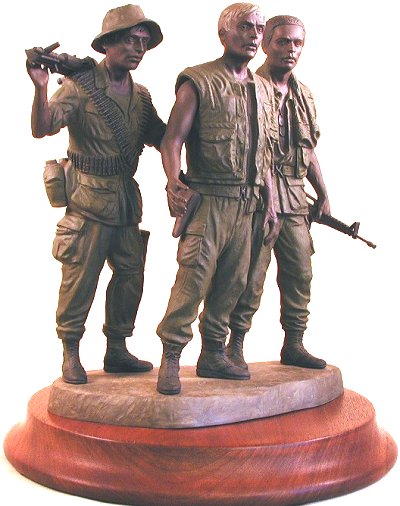
With the basic concept finalized, Frederick created a series of cast-bronze maquettes in ever-increasing scales. Each of these small sculptures helped to evolve the tribute and fine-tune the presentation’s impact and visual symmetry. Minor repositioning of the figures’ limbs and some small changes to their stances and to their accoutrements with each subsequent maquette resulted in the final permutation which was given production approval late in the year. To create the dramatic effect necessary, Mr. Hart elected to cast the sculpture in 7:6 scale, substantially larger than the full-size figures themselves.
Multi-piece molds were created from high-temperature ceramic material and the figures were cast in hot bronze in sub-assembly fashion. Each component was individually polished and finished, then brazed together with a torch. All the welding joints were then ground down and dressed out, resulting in seemingly seamless construction. The completed figures would ultimately be mounted on a single slab of smooth, semi-polished granite prior to the public unveiling of the sculpture in November 1984 amid a flurry of fanfare among veterans, veterans’ groups, military units, and the usual coterie of political dignitaries including President Reagan. The sculpture is located opposite to the wall itself, with the soldiers positioned as it they were looking for their own names engraved there.
Frederick’s interpretation was an immediate hit and the immense popularity helped to coalesce the entire memorial’s purpose and rekindle the respect for Vietnam veterans among the population at-large that had been lacking in some quarters for many years. Those who had held the original stand-alone marble design in contempt began to proudly refer to the memorial as “The Wall”, and at that point the healing of their, and the nation’s wounds truly began. Even today, amidst the myriad of landmarks and tourist attractions in Washington, thousands make the memorial a “must-see” when touring the nation’s capitol.
|
THE KIT |
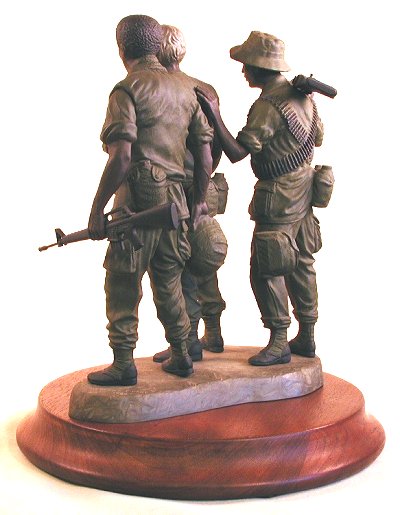 Monogram’s “Three Fighting Men” kit is of ‘Snap-Tite’ design, featuring
twenty-six parts molded in a copper-colored, metallic-swirled plastic. An
instruction pamphlet offers a recommended assembly sequence and some interesting
data concerning the sculpture and Frederick E. Hart himself. No decals are
provided as none are required.
Monogram’s “Three Fighting Men” kit is of ‘Snap-Tite’ design, featuring
twenty-six parts molded in a copper-colored, metallic-swirled plastic. An
instruction pamphlet offers a recommended assembly sequence and some interesting
data concerning the sculpture and Frederick E. Hart himself. No decals are
provided as none are required.
The moldings are well done and the flash-free parts fit together adequately for a Snap-Tite, though less so for a serious model. The two-piece arms are designed to be assembled then trapped between the respective torso halves. Large pegs at the bottom of each jungle boot correspond to holes in the base, ensuring proper alignment when the figures are mounted.
The faces and bared arms are well sculpted though some of the fingers need some minor reshaping to make them convincing. Assembly seams through the heads will make re-contouring the hair a necessity, along with the 7.62 ammo belts carried by the machine-gunner. The molded dog-tags require some definition and enhancement as well.
The weapons and equipment carried by each figure are for the most part correct, though some prominent details are missing from the M-60 machinegun and the rifle (more on this later). The flak vests and slant-pocket jungle fatigues are spot on, being specifically designed for the war in Vietnam. Likewise, the boonie hat is also well depicted.
This kit seems to be based on Mr. Hart’s first bronze-cast maquette and as such, there are some minor differences between it and the actual sculpture on display at the Vietnam Veterans’ Memorial in Washington. Not to detract from the model, I note this only to present an accurate assessment of what this kit is. The scale is listed as 1:10 and that figure seems correct.
|
CONSTRUCTION |
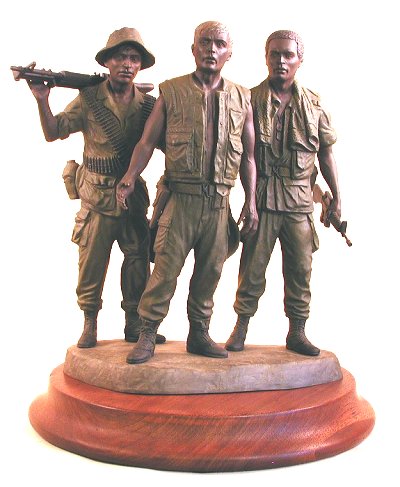 Predictably, I began construction with the arms, gluing each limb together with
CA to fill small gaps and blend the seams. Next, the torsos were assembled and
all the joints sanded and dressed. As noted in the section above, the seams
through the heads required some major work and after they’d been properly glued
and sanded, I used my Dremel tool and a routing bit to restore the contours to
the hair on the bare-headed figures and the rifleman’s ‘lucky towel’. After
dimpling and stippling these areas to match the adjacent detail, I brushed
Testor’s liquid cement over the parts to smooth the tooling marks away.
Predictably, I began construction with the arms, gluing each limb together with
CA to fill small gaps and blend the seams. Next, the torsos were assembled and
all the joints sanded and dressed. As noted in the section above, the seams
through the heads required some major work and after they’d been properly glued
and sanded, I used my Dremel tool and a routing bit to restore the contours to
the hair on the bare-headed figures and the rifleman’s ‘lucky towel’. After
dimpling and stippling these areas to match the adjacent detail, I brushed
Testor’s liquid cement over the parts to smooth the tooling marks away.
To restore the lost detail on the machine-gunner’s draped M-80 Ball ammo belts where the seams ran through, I hand-carved and chiseled these areas with an X-acto knife and several jeweler’s files. Liquid cement was used here as well to reconcile the re-created detail with the molded features. The belted equipment was cleaned up and attached with Crazy Glue, with some minor filling required to fit the gear properly to the figures. The M-17 gas mask carried by the gunner seems a bit spurious—this item was generally carried and used only by tunnel rats, where CS gas was a preferred method of routing the VC and NVA from bunkers, caves, and other underground complexes.
The weapons lack much of the detail visible on the prototype but rather than do a super-detailing job on them (which I felt would draw attention away from the model’s central focus), I cleaned them up and used them as is, adding only a knurled bolt handle for the M-60, since this detail is plainly visible on the full-size sculpture. With the small arms ready to install I moved to the final assembly phase.
I removed the retaining bosses from each arm, leaving only the peg at the shoulder for ease of installation. CA was used here, applied with a small-diameter vinyl tube stuck in the end of the glue dispenser for better control. The machine-gunner’s right arm was tacked on with liquid cement so I could properly position the M-60 on his shoulder and integrate it with the limb. After some adjustment, this limb was also permanently attached with Crazy Glue. Adding his boonie hat completed the basic assembly and the figures were sent to the paint shop.
|
PAINT |
 The actual statue is not a monotone bronze color, but instead has the uniforms,
equipment and weapons colored with epoxy paint. Bare skin areas are left ‘in
the rough’ though the rifleman is obviously Black and a case can be made for the
machine-gunner appearing to be a Latino. This was apparently a deliberate
effort to convey to the viewer the universal demographic that the conscripted
Army of the time had become and the sense of camaraderie and unity that
brothers-in-arms feel toward one another.
The actual statue is not a monotone bronze color, but instead has the uniforms,
equipment and weapons colored with epoxy paint. Bare skin areas are left ‘in
the rough’ though the rifleman is obviously Black and a case can be made for the
machine-gunner appearing to be a Latino. This was apparently a deliberate
effort to convey to the viewer the universal demographic that the conscripted
Army of the time had become and the sense of camaraderie and unity that
brothers-in-arms feel toward one another.
Consequently, the flesh areas were brush-painted using a medium brown, mixed with a small amount of red. The web gear and uniforms were done in SAC Bomber Green (FS 34159) after matching this color to a set of slant-pocket rip-stop poplin fatigues that I was issued some years ago, one of many such artifacts hanging proudly in my closet. The weapons were done in flat black, with powdered graphite burnished onto the metallic areas to simulate the parkerized finish typical of military small arms.
Powdered artists’ pastels were used to tone down and blend the colors while dry-brushing with lighter shades brought out more of the highlights. Testor’s Dullcote was used to seal these effects and give the figures an overall semi-matte sheen (note: the actual sculpture was overcoated with a clear weatherproof gloss acrylic—I initially tried to replicate this finish but it lent a ‘toy-like’ appearance to the model). I sprayed the base with various shades of gray and used powdered graphite to blend the hues and simulate the sheen of semi-polished granite.
To permanently mount the figures, I drilled large holes through the bottom of the base in each foot’s socket, positioned the figures individually, and glued them from the backside using CA. As an afterthought, I found a nice mahogany pedestal which I sanded, stained, and sealed with satin-finish polyurethane sprayed from an aerosol can. It compliments the model well and provides a nice, finished look to the overall presentation.
|
CONCLUSIONS |
Though currently out of production, this kit may be found in many military museum gift shops and the usual swap-meet venues. Compared to many of the commercially available copies in porcelain from Franklin Mint and the Bradford Exchange this tribute fares well if the Snap-Tite aspects are ignored and the model is competently assembled and painted in the conventional manner. Minor accuracy issues aside, it’s a fine representation that any Vietnam veteran, family member, or merely someone who simply gave a damn what happened to those of us who wore the uniform during this divisive period in our nation’s history will enjoy building and displaying.
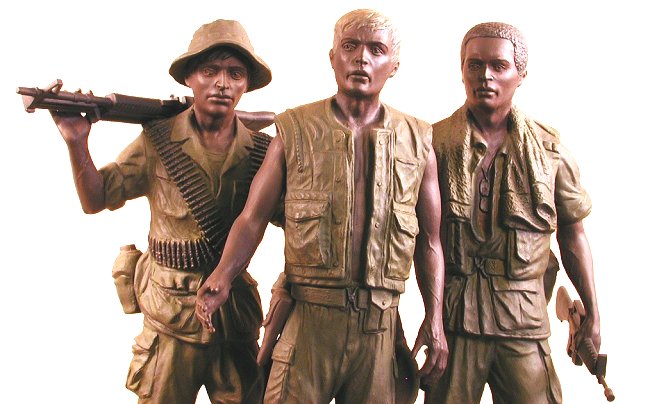
|
REFERENCES |
Various photographs and articles appearing in the VFW and American Legion journals, Soldier magazine, the Army Times, and numerous military-themed websites.
If you would like your product reviewed fairly and quickly by a site that has well over 100,000 visitors a month, please contact me or see other details in the Note to Contributors.